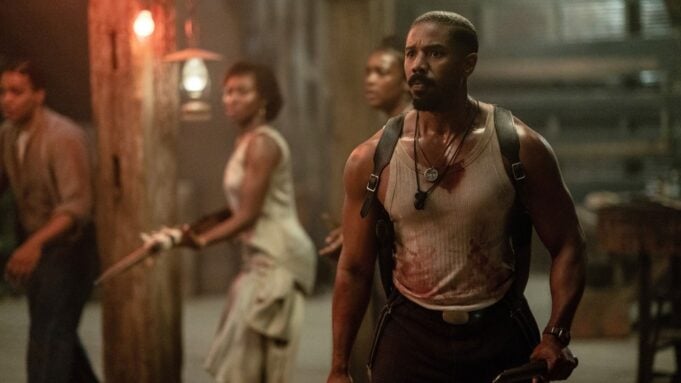“Sinners,” written and directed by Ryan Coogler, is a lush, enveloping, historical, phantasmagorical social-panorama from-dusk-till-dawn vampire film. It’s a richly imagined, vibrantly acted portrait of a Deep South community in the early 1930s. It’s also a wild and bloody throat-ripping blowout — a thriller that pushes the vampire-as-metaphor thing about as far as it can go. (The film has a lot on its mind.) “Sinners” works more than it doesn’t, even if it doesn’t always gel, but it’s a commanding demonstration of how lavishly spirited and “serious” a popcorn movie can be.
It’s set in 1932, over one long day and night in the rural town of Clarksdale, Mississippi, a place of sharecroppers and blues singers and racist rednecks and sexy pent-up passion. Michael B. Jordan, in a dual role, plays the Smokestack twins, Smoke and Stack, who grew up in Clarksdale but left to fight on the German front in World War I and wound up in Chicago, where they worked for Al Capone and honed their underworld skills. They’ve been hustlers, pimps, and killers. Now they’ve returned to their hometown, in the land of Jim Crow, because as one of them puts it, “Chicago ain’t nothing but Mississippi with tall buildings.”
Jordan’s double performance is introduced with state-of-the-art digital trickery, as the two characters pass a cigarette back and forth, and the film makes a sly point of not distinguishing them in any super-obvious way. Smoke sports a blue British flat cap; Stack wears a red brimmed hat and has two of his teeth outlined in gold. But they’ve got the same thick goatee, the same hefty muscled handsomeness, the same airy down-home crushed-mint drawl.
We’ve got to look closer to pick up on the difference, which is there in Stack’s soft smile, and Smoke’s lack of one; in Stack’s tough but coiled willingness to cut people a break, and Stack’s colder attitude. Jordan makes the differences quiet and subtle and bone-deep, the way Robert De Niro did in his criminally underrated double performance in “The Alto Knights.” The Smokestack twins are the crooked version of a good and bad cop, though with spirits joined at the well-dressed hip. And Jordan invests them with consummate star panache.
Horror movies often have grandiose themes, but “Sinners” is the rare mainstream horror film that’s about something weighty and soulful: the wages of sin in Black America, an idea that in the movie extends from the embrace of criminality as a way to transcend oppression to the literal “deal with the devil” that Robert Johnson is said to have made at a crossroads to gain his world-shaking musical gift. (As the visionary of the blues, he was essentially the inventor of rock ‘n’ roll.)
Robert Johnson doesn’t appear in “Sinners,” but one of the film’s main characters, who would have been born around the same time (in 1911), is Sammie Moore (newcomer Miles Caton), known as Preacher Boy, and he’s got a singular talent — his twanging guitar and lyrical voice seem to swing the blues right up to the sky. He’s the Smokestack twins’ cousin, and they engage him to play at the juke joint. They make the same offer to Delta Slim, a broken down old tough-dog harmonica and piano player (played by a pitch-perfect Delroy Lindo) who will go anywhere if there’s enough liquor (the twins have brought 500 bottles of Irish beer from up north).
For 12 years now, Ryan Coogler has built his career — and his power in Hollywood — with a step-by-step methodical savvy. Having established himself, with the wrenching “Fruitvale Station” (2013), as a potential heir to a filmmaker like Scorsese, Coogler made “Creed” (2015), a “Rocky” spinoff as shrewd and heartfelt as spinoffs get, and then stepped into the blockbuster chair with the triumphant “Black Panther” (2018) and its sequel, which sent him to the top of the A-list. He’s now the rare filmmaker who can call the shots. Given that clout, “Sinners” is a movie that tells us a lot about Coogler, and also about where movie culture is today.
Love Film & TV?
Get your daily dose of everything happening in music, film and TV in Australia and abroad.
In many ways, “Sinners” is a personal vision, steeped in its nervy and expansive collage of ’30s Black America. The movie is exquisitely shot, with Autumn Durald Arkapaw’s cinematography immersing us in the sunlit splendor and leafy ominousness of back-country Mississippi. It’s also the fifth film (out of five) that Coogler has made with Jordan, and you feel the director’s flair in the supple way that he gets us onto Smoke and Stack’s wavelength, making us eager to see them succeed. For all their strong-arm tactics, these two carry themselves as formidable businessmen. To make the juke joint work, they want to put on a show that will stop the night. That’s how they intend to make a killing, which is exactly what happens, though not in the way they planned.
If you didn’t go in knowing that “Sinners” was a horror film, you wouldn’t guess it from the first hour. It’s got that much realistic vivacity. The Smokestack twins literally spend a single afternoon putting together the juke joint’s opening (which is that very night), and the more people they line up to help (buying the catfish and commissioning the joint’s billboard sign from the Chinese couple, played by Li Jun Li and Yao, who operate the local grocery store), the more engaged we are by this community. Each twin has left a woman behind, and that’s part of the film’s layering. Mary, played by Hailee Steinfeld with aristocratic airs (more than ever, she seems born to play Elizabeth Taylor), was loved and abandoned by Stack, and though he won’t say it aloud it’s clear that what made him cut off the relationship was the impossibility, in his mind, of sustaining it in a racist world. Smoke abandoned Annie, the local medicine woman he had a baby with (the infant died). She’s played by Wunmi Mosaku, an actor who has come out of next to nowhere, and look out — she’s a powerhouse of stern passion.
I’ll confess I was so enmeshed in these characters that it hit me with a twinge of disappointment when Remmick (Jack O’Connell), a pesky varmint of a vampire, shows up at the home of a farm couple (they have a Klan sheet and hood crumpled against the wall), and before long all three are sporting pinpoint glowy red eyes and bloody fangs. This is Coogler making the movie he wants to make (following the template, perhaps, of Jordan Peele). Yet you can also hear the siren song of the megaplex calling, saying, “What hope will a mainstream movie have for success if it isn’t a fantasy?” Forgive me, but I don’t want to see the Scorsese side of Ryan Coogler get swallowed up by that.
Vampire metaphors are almost always erotic, but despite the rather steamy atmosphere of “Sinners” (at the juke joint, there’s a whole lotta hookin’ up goin’ on), that’s not what it means here. The vampires are presented as extensions of the racist white culture that wants to stop the party. The three vampires show up at the joint, but the way vampire protocol works they’ve got to be invited in in order to enter. And Smoke and Stack are too suspicious to kowtow to these gate crashers. But that’s okay — they’ll infiltrate it a different way, by getting Mary to come out and talk to them (as they play a nice folk song).
The vampires promise eternal life, but they’re like zombies who have come to leech away your freedom. And that, in the case of this setting, takes on a more heightened meaning, since the Black characters are already searching for a taste of freedom, which they find through the liberating spirit of the juke joint. Once the key characters are trapped and fighting for their lives, “Sinners” becomes a tale of vampirism as cult. There’s a terrifically creepy scene in which the vampires, led by O’Connell’s fiery-eyed Remmick, go into an Irish step dance (at this point there are Black vampires who’ve been bitten and are part of the cult), and the message is: Give up your freedom and join us!
Coogler, at one point, stages a long and winding shot through the dance floor, and we spot a reveler who looks like he stepped off the stage of a Parliament/Funkadelic concert, then a break dancer and a hip-hop DJ and other out-of-time musical figures, and the message is: All of that started right here. (That may be a bit preachy, but the sinuous staging makes it work.) Yet Coogler also loads the movie — maybe overloads it — with a dual mythology. The music is liberating, the sound of a new world, which the vampires want to shut down. But it is also, à la the Robert Johnson legend, music with a demonic tinge. Preacher Boy, playing the guitar he was given by the twins (Smoke tells him it’s Charlie Patton’s), is the son of the local preacher. He’s breaking away from the church to play the devil’s music. But is that what “Sinners” seriously believes? Stay tuned for the lengthy post-credits sequence, which is more than a teaser — it’s the place where Coogler, casting the blues veteran Buddy Guy, completes his film’s fanciful cosmology. Though maybe he should have made it a little less fancy.
From Variety US































